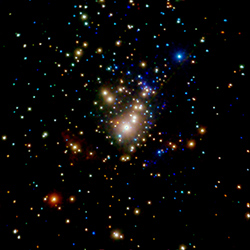Stars as X-ray Sources

From our vantage point on Earth, the Sun is the brightest X-ray source. But, if we were much further away from the Sun, it would fade into the background of much brighter X-ray sources. Compared to other sources out there, it just isn't a strong X-ray emitter.
The X-rays we see from normal, main sequence stars, are not the surfaces, but the coronae, just like what we see from our Sun. Most of the fine details we can see in our Sun are lost when we observe stars much farther away, but we can still study how the X-ray emissions vary from star to star. In this way, scientists have been able to learn a great deal about the relationship between the X-ray emissions and other properties of the stars, such as the mass, the age, the rotation period, and the chemical composition.
Young stars, those less than a few hundred million years old, can be strong X-ray sources. In fact, our Sun was probably about a thousand times brighter in X-rays when it was only a few million years old.
Young stars are born with a disk of gas and dust, some of which will fall into the young star. As the material falls, it is accelerated and can emit X-rays.
Updated: March 2014
Additional Links
- Quiz me about this topic
- Cool fact about this topic
- Try this!
- FAQs on Stars
- Give me additional resources


